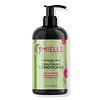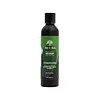What's inside
What's inside
 Key Ingredients
Key Ingredients

No key ingredients
 Benefits
Benefits

 Concerns
Concerns

 Ingredients Side-by-side
Ingredients Side-by-side

Water
Skin ConditioningCetearyl Alcohol
EmollientPolyquaternium-7
Caprylic/Capric Triglyceride
MaskingBehentrimonium Chloride
PreservativeC12-15 Alkyl Benzoate
AntimicrobialParfum
MaskingPersea Gratissima Oil
Skin ConditioningPPG-3 Myristyl Ether
EmollientBiotin
AntiseborrhoeicButyrospermum Parkii Butter
Skin ConditioningCocos Nucifera Oil
MaskingRosmarinus Officinalis Leaf Oil
MaskingMentha Piperita Oil
MaskingOlea Europaea Fruit Oil
MaskingPanthenol
Skin ConditioningBehentrimonium Methosulfate
Diheptyl Succinate
EmollientCapryloyl Glycerin/Sebacic Acid Copolymer
Skin ConditioningCetyl Alcohol
EmollientWater, Cetearyl Alcohol, Polyquaternium-7, Caprylic/Capric Triglyceride, Behentrimonium Chloride, C12-15 Alkyl Benzoate, Parfum, Persea Gratissima Oil, PPG-3 Myristyl Ether, Biotin, Butyrospermum Parkii Butter, Cocos Nucifera Oil, Rosmarinus Officinalis Leaf Oil, Mentha Piperita Oil, Olea Europaea Fruit Oil, Panthenol, Behentrimonium Methosulfate, Diheptyl Succinate, Capryloyl Glycerin/Sebacic Acid Copolymer, Cetyl Alcohol
Water
Skin ConditioningGlycerin
HumectantBetaine
HumectantCetearyl Alcohol
EmollientCetyl Alcohol
EmollientBis-Octyldodecyl Dimer Dilinoleate/Propanediol Copolymer
EmollientLinum Usitatissimum Seed Extract
PerfumingBrassicamidopropyl Dimethylamine
Skin ConditioningRosmarinus Officinalis Leaf Oil
MaskingCaffeine
Skin ConditioningMentha Piperita Oil
MaskingSerenoa Serrulata Fruit Extract
Skin ConditioningCeramide NP
Skin ConditioningCopper Tripeptide-1
Skin ConditioningCopper Tripeptide-34
Skin ConditioningBiotin
AntiseborrhoeicInositol
HumectantPhytosterols
Skin ConditioningMenthol
MaskingMelatonin
AntioxidantLactic Acid
BufferingSarcosine
Skin ConditioningPolyglyceryl-10 Laurate
Skin ConditioningPotassium Olivate
EmulsifyingCaprylhydroxamic Acid
Caprylyl Glycol
EmollientSodium Benzoate
MaskingPotassium Sorbate
PreservativeWater, Glycerin, Betaine, Cetearyl Alcohol, Cetyl Alcohol, Bis-Octyldodecyl Dimer Dilinoleate/Propanediol Copolymer, Linum Usitatissimum Seed Extract, Brassicamidopropyl Dimethylamine, Rosmarinus Officinalis Leaf Oil, Caffeine, Mentha Piperita Oil, Serenoa Serrulata Fruit Extract, Ceramide NP, Copper Tripeptide-1, Copper Tripeptide-34, Biotin, Inositol, Phytosterols, Menthol, Melatonin, Lactic Acid, Sarcosine, Polyglyceryl-10 Laurate, Potassium Olivate, Caprylhydroxamic Acid, Caprylyl Glycol, Sodium Benzoate, Potassium Sorbate
Ingredients Explained
These ingredients are found in both products.
Ingredients higher up in an ingredient list are typically present in a larger amount.
Biotin is a B vitamin that is naturally produced by our bodies. It is also called Vitamin H.
Our bodies use biotin in the metabolism process. It also helps our bodies use enzymes and move nutrients around. A biotin deficiency can lead to brittle hair and nails.
More research is needed on applying biotin topically. However, taking biotin orally has been shown to help nourish the skin, hair, and nails. They play a role in forming skin-hydrating fatty acids.
Biotin is water-soluble. It can be found in foods such as fish, eggs, dairy, nuts, and meat. Vitamin H stands for "haar" and "haut". These are the German words for hair and skin.
Learn more about BiotinCetearyl alcohol is a mixture of two fatty alcohols: cetyl alcohol and stearyl alcohol. It is mainly used as an emulsifier. Emulsifiers help prevent the separation of oils and products. Due to its composition, it can also be used to thicken a product or help create foam.
Cetearyl alcohol is an emollient. Emollients help soothe and hydrate the skin by trapping moisture.
Studies show Cetearyl alcohol is non-toxic and non-irritating. The FDA allows products labeled "alcohol-free" to have fatty alcohols.
This ingredient is usually derived from plant oils such as palm, vegetable, or coconut oils. There is debate on whether this ingredient will cause acne.
Due to the fatty acid base, this ingredient may not be Malassezia folliculitis safe.
Learn more about Cetearyl AlcoholCetyl Alcohol is a fatty alcohol. Fatty Alcohols are most often used as an emollient or to thicken a product.
Its main roles are:
Though it has "alcohol" in the name, it is not related to denatured alcohol or ethyl alcohol.
The FDA allows products labeled "alcohol-free" to have fatty alcohols.
Learn more about Cetyl AlcoholMentha Piperita Oil is the volatile oil obtained from the whole plant of the Peppermint plant.
It can be used to add a fresh scent to products.
Peppermint oil may cause skin sensitivity and redness due to its menthol content. Menthol also has a cooling effect (like your toothpaste).
Learn more about Mentha Piperita OilRosmarinus Officinalis Leaf Oil is oil expressed from the leaves of the rosemary plant.
Rosemary Leaf Oil is a fragrance and helps give your product a scent. If you are sensitive to irritating fragrances, this one contains camphor. Camphor has been found to irritate skin.
This oil also contains antioxidant and antimicrobial properties. As an antioxidant, it may protect you skin against damage. This can help slow down the signs of aging.
Learn more about Rosmarinus Officinalis Leaf OilWater. It's the most common cosmetic ingredient of all. You'll usually see it at the top of ingredient lists, meaning that it makes up the largest part of the product.
So why is it so popular? Water most often acts as a solvent - this means that it helps dissolve other ingredients into the formulation.
You'll also recognize water as that liquid we all need to stay alive. If you see this, drink a glass of water. Stay hydrated!
Learn more about Water